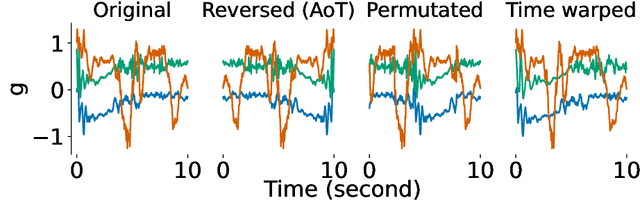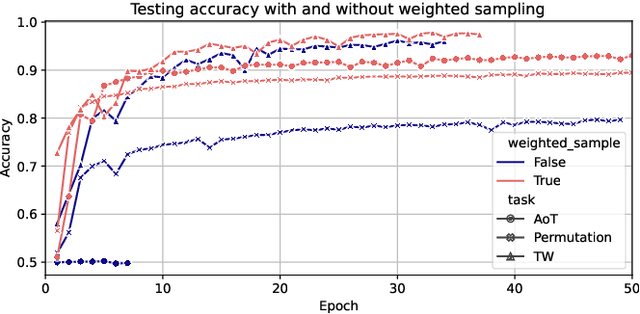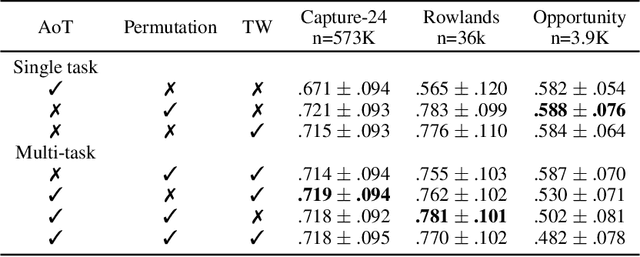Hang Yuan
Sun Yat-Sen University
Fréchet Cumulative Covariance Net for Deep Nonlinear Sufficient Dimension Reduction with Random Objects
Feb 21, 2025Abstract:Nonlinear sufficient dimension reduction\citep{libing_generalSDR}, which constructs nonlinear low-dimensional representations to summarize essential features of high-dimensional data, is an important branch of representation learning. However, most existing methods are not applicable when the response variables are complex non-Euclidean random objects, which are frequently encountered in many recent statistical applications. In this paper, we introduce a new statistical dependence measure termed Fr\'echet Cumulative Covariance (FCCov) and develop a novel nonlinear SDR framework based on FCCov. Our approach is not only applicable to complex non-Euclidean data, but also exhibits robustness against outliers. We further incorporate Feedforward Neural Networks (FNNs) and Convolutional Neural Networks (CNNs) to estimate nonlinear sufficient directions in the sample level. Theoretically, we prove that our method with squared Frobenius norm regularization achieves unbiasedness at the $\sigma$-field level. Furthermore, we establish non-asymptotic convergence rates for our estimators based on FNNs and ResNet-type CNNs, which match the minimax rate of nonparametric regression up to logarithmic factors. Intensive simulation studies verify the performance of our methods in both Euclidean and non-Euclidean settings. We apply our method to facial expression recognition datasets and the results underscore more realistic and broader applicability of our proposal.
Smart-LLaMA: Two-Stage Post-Training of Large Language Models for Smart Contract Vulnerability Detection and Explanation
Nov 09, 2024Abstract:With the rapid development of blockchain technology, smart contract security has become a critical challenge. Existing smart contract vulnerability detection methods face three main issues: (1) Insufficient quality of datasets, lacking detailed explanations and precise vulnerability locations. (2) Limited adaptability of large language models (LLMs) to the smart contract domain, as most LLMs are pre-trained on general text data but minimal smart contract-specific data. (3) Lack of high-quality explanations for detected vulnerabilities, as existing methods focus solely on detection without clear explanations. These limitations hinder detection performance and make it harder for developers to understand and fix vulnerabilities quickly, potentially leading to severe financial losses. To address these problems, we propose Smart-LLaMA, an advanced detection method based on the LLaMA language model. First, we construct a comprehensive dataset covering four vulnerability types with labels, detailed explanations, and precise vulnerability locations. Second, we introduce Smart Contract-Specific Continual Pre-Training, using raw smart contract data to enable the LLM to learn smart contract syntax and semantics, enhancing their domain adaptability. Furthermore, we propose Explanation-Guided Fine-Tuning, which fine-tunes the LLM using paired vulnerable code and explanations, enabling both vulnerability detection and reasoned explanations. We evaluate explanation quality through LLM and human evaluation, focusing on Correctness, Completeness, and Conciseness. Experimental results show that Smart-LLaMA outperforms state-of-the-art baselines, with average improvements of 6.49% in F1 score and 3.78% in accuracy, while providing reliable explanations.
The high dimensional psychological profile and cultural bias of ChatGPT
May 06, 2024Abstract:Given the rapid advancement of large-scale language models, artificial intelligence (AI) models, like ChatGPT, are playing an increasingly prominent role in human society. However, to ensure that artificial intelligence models benefit human society, we must first fully understand the similarities and differences between the human-like characteristics exhibited by artificial intelligence models and real humans, as well as the cultural stereotypes and biases that artificial intelligence models may exhibit in the process of interacting with humans. This study first measured ChatGPT in 84 dimensions of psychological characteristics, revealing differences between ChatGPT and human norms in most dimensions as well as in high-dimensional psychological representations. Additionally, through the measurement of ChatGPT in 13 dimensions of cultural values, it was revealed that ChatGPT's cultural value patterns are dissimilar to those of various countries/regions worldwide. Finally, an analysis of ChatGPT's performance in eight decision-making tasks involving interactions with humans from different countries/regions revealed that ChatGPT exhibits clear cultural stereotypes in most decision-making tasks and shows significant cultural bias in third-party punishment and ultimatum games. The findings indicate that, compared to humans, ChatGPT exhibits a distinct psychological profile and cultural value orientation, and it also shows cultural biases and stereotypes in interpersonal decision-making. Future research endeavors should emphasize enhanced technical oversight and augmented transparency in the database and algorithmic training procedures to foster more efficient cross-cultural communication and mitigate social disparities.
Alpha-GPT 2.0: Human-in-the-Loop AI for Quantitative Investment
Feb 15, 2024

Abstract:Recently, we introduced a new paradigm for alpha mining in the realm of quantitative investment, developing a new interactive alpha mining system framework, Alpha-GPT. This system is centered on iterative Human-AI interaction based on large language models, introducing a Human-in-the-Loop approach to alpha discovery. In this paper, we present the next-generation Alpha-GPT 2.0 \footnote{Draft. Work in progress}, a quantitative investment framework that further encompasses crucial modeling and analysis phases in quantitative investment. This framework emphasizes the iterative, interactive research between humans and AI, embodying a Human-in-the-Loop strategy throughout the entire quantitative investment pipeline. By assimilating the insights of human researchers into the systematic alpha research process, we effectively leverage the Human-in-the-Loop approach, enhancing the efficiency and precision of quantitative investment research.
QuantAgent: Seeking Holy Grail in Trading by Self-Improving Large Language Model
Feb 06, 2024Abstract:Autonomous agents based on Large Language Models (LLMs) that devise plans and tackle real-world challenges have gained prominence.However, tailoring these agents for specialized domains like quantitative investment remains a formidable task. The core challenge involves efficiently building and integrating a domain-specific knowledge base for the agent's learning process. This paper introduces a principled framework to address this challenge, comprising a two-layer loop.In the inner loop, the agent refines its responses by drawing from its knowledge base, while in the outer loop, these responses are tested in real-world scenarios to automatically enhance the knowledge base with new insights.We demonstrate that our approach enables the agent to progressively approximate optimal behavior with provable efficiency.Furthermore, we instantiate this framework through an autonomous agent for mining trading signals named QuantAgent. Empirical results showcase QuantAgent's capability in uncovering viable financial signals and enhancing the accuracy of financial forecasts.
Alpha-GPT: Human-AI Interactive Alpha Mining for Quantitative Investment
Jul 31, 2023Abstract:One of the most important tasks in quantitative investment research is mining new alphas (effective trading signals or factors). Traditional alpha mining methods, either hand-crafted factor synthesizing or algorithmic factor mining (e.g., search with genetic programming), have inherent limitations, especially in implementing the ideas of quants. In this work, we propose a new alpha mining paradigm by introducing human-AI interaction, and a novel prompt engineering algorithmic framework to implement this paradigm by leveraging the power of large language models. Moreover, we develop Alpha-GPT, a new interactive alpha mining system framework that provides a heuristic way to ``understand'' the ideas of quant researchers and outputs creative, insightful, and effective alphas. We demonstrate the effectiveness and advantage of Alpha-GPT via a number of alpha mining experiments.
Queer In AI: A Case Study in Community-Led Participatory AI
Apr 10, 2023Abstract:We present Queer in AI as a case study for community-led participatory design in AI. We examine how participatory design and intersectional tenets started and shaped this community's programs over the years. We discuss different challenges that emerged in the process, look at ways this organization has fallen short of operationalizing participatory and intersectional principles, and then assess the organization's impact. Queer in AI provides important lessons and insights for practitioners and theorists of participatory methods broadly through its rejection of hierarchy in favor of decentralization, success at building aid and programs by and for the queer community, and effort to change actors and institutions outside of the queer community. Finally, we theorize how communities like Queer in AI contribute to the participatory design in AI more broadly by fostering cultures of participation in AI, welcoming and empowering marginalized participants, critiquing poor or exploitative participatory practices, and bringing participation to institutions outside of individual research projects. Queer in AI's work serves as a case study of grassroots activism and participatory methods within AI, demonstrating the potential of community-led participatory methods and intersectional praxis, while also providing challenges, case studies, and nuanced insights to researchers developing and using participatory methods.
The Meta Distribution of SINR in UAV-Assisted Cellular Networks
Jan 30, 2023Abstract:Mounting compact and lightweight base stations on unmanned aerial vehicles (UAVs) is a cost-effective and flexible solution to provide seamless coverage on the existing terrestrial networks. While the coverage probability in UAV-assisted cellular networks has been widely investigated, it provides only the first-order statistic of signal-to-interference-plus-noise ratio (SINR). In this paper, to analyze high-order statistics of SINR and characterize the disparity among individual links, we provide a meta distribution (MD)-based analytical framework for UAV-assisted cellular networks, in which the probabilistic line-of-sight channel and realistic antenna pattern are taken into account for air-to-ground transmissions. To accurately characterize the interference from UAVs, we relax the widely applied uniform off-boresight angle (OBA) assumption and derive the exact distribution of OBA. Using stochastic geometry, for both steerable and vertical antenna scenarios, we obtain mathematical expressions for the moments of condition success probability, the SINR MD, and the mean local delay. Moreover, we study the asymptotic behavior of the moments as network density approaches infinity. Numerical results validate the tightness of the theoretical results and show that the uniform OBA assumption underestimates the network performance, especially in the regime of moderate altitude of UAV. We also show that when UAVs are equipped with steerable antennas, the network coverage and user fairness can be optimized simultaneously by carefully adjusting the UAV parameters.
Self-supervised Learning for Human Activity Recognition Using 700,000 Person-days of Wearable Data
Jun 06, 2022



Abstract:Advances in deep learning for human activity recognition have been relatively limited due to the lack of large labelled datasets. In this study, we leverage self-supervised learning techniques on the UK-Biobank activity tracker dataset--the largest of its kind to date--containing more than 700,000 person-days of unlabelled wearable sensor data. Our resulting activity recognition model consistently outperformed strong baselines across seven benchmark datasets, with an F1 relative improvement of 2.5%-100% (median 18.4%), the largest improvements occurring in the smaller datasets. In contrast to previous studies, our results generalise across external datasets, devices, and environments. Our open-source model will help researchers and developers to build customisable and generalisable activity classifiers with high performance.
 Add to Chrome
Add to Chrome Add to Firefox
Add to Firefox Add to Edge
Add to Edge